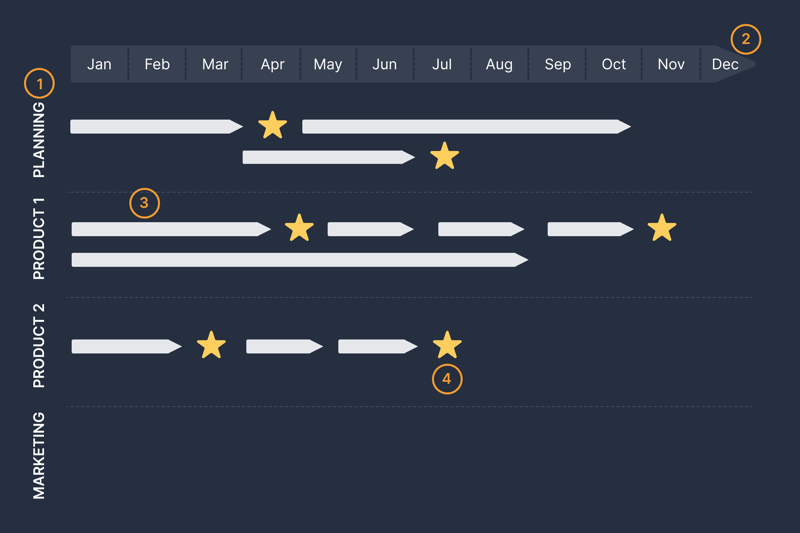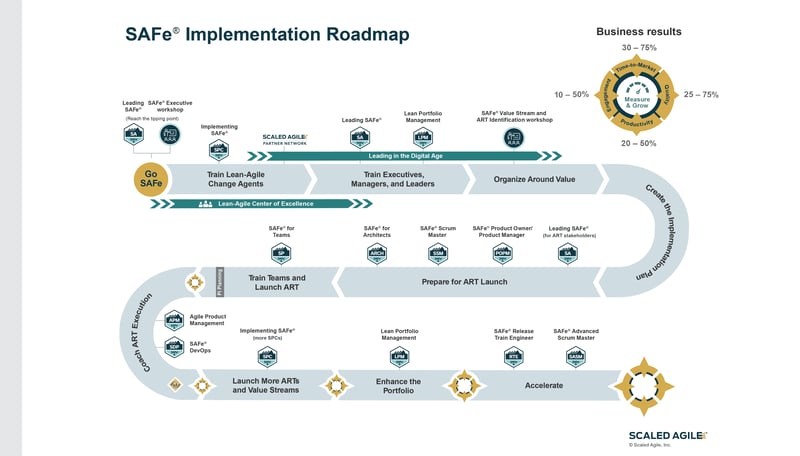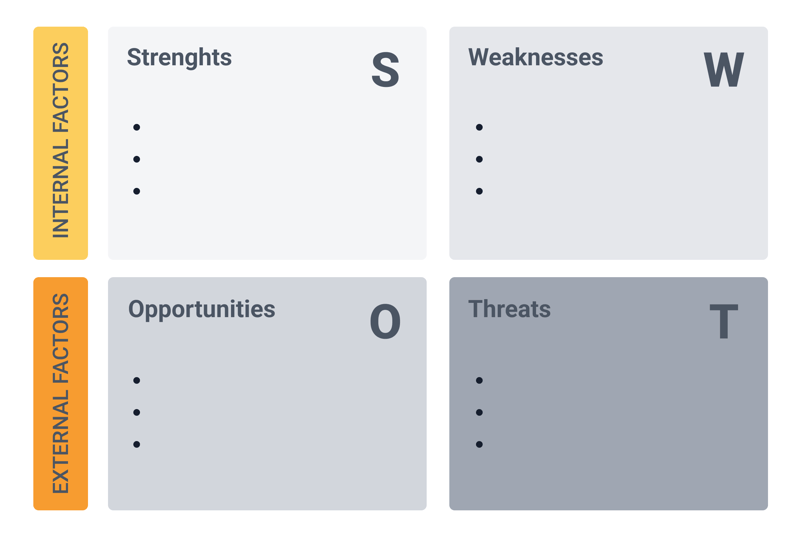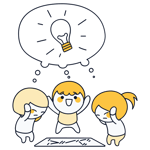Have you ever heard of a successful company that doesn't have goals? Neither have we. In the fast-paced world of business, the road to success is often fraught with danger and surprises. A clear roadmap can show the way toward your organization's goals and ultimately, glory. So what should this look like?
In this article, we'll let you know what's needed for a roadmap and how you can create one in a few steps. We'll also discuss whether a roadmap is necessary in an agile environment and will give you some tips for how to use one in practice.
What Is a Roadmap?
Before GPS and satellite navigation, a roadmap was how anyone in a car planned a trip to another city or destination. While you can still find them today at gas stations, in project management, the term has a different meaning:
A basic visual representation of goals, milestones, and results.
Just like a regular map, a roadmap shows how a business or project can get from point A to point B. In the corporate world, this refers to the distance between where the organization is currently and the achievement of its goals or objectives. As such, it offers both a navigation tool and a strategic overview.
Visualization and Main Elements
Unlike most project management methods, there isn't a standard way to visualize a roadmap. A business can adjust it in terms of scale, expectations, and detail. With that said, there are two prevalent approaches, and most associate a roadmap with the following structure:

Many roadmaps look similar to a Gantt diagram.
These are the primary components:
- 1.
Swimlane: This is a visual representation that organizes and delineates tasks, processes, or responsibilities within specific areas or categories on a diagram. Although they aren't necessary, they do help to display and organize information. Some compare them to chapters in a book. To ensure clarity, these can be arranged as projects, departments, resources, or even phases.
- 2.
Timeline: Nearly every roadmap has a timeline. This shows when specific goals are to be completed.
- 3.
Tasks/Assignments: These reflect what needs to be done and when. If you arrange these on a swimlane, you can easily show which project or department is responsible for them.
- 4.
Milestones/Goals: Specify which milestones and/or goals you want to achieve.
There are other ways to visualize a roadmap. For example, SAFe, an agile framework, looks like this:

A SAFe roadmap looks much more like an actual map than the first visualization.
A SAFe roadmap proceeds along an actual route. Viewers can clearly see where the organization presently is, which assignments there will be in the future, and what the goal at the end is.
Different Uses of Roadmaps
Roadmaps do vary in appearance. Only management can determine which variant is right for your business or organization. With that said, their purpose/intended use can play a significant role.
Project roadmap
This visualizes the path a specific project should take. Steps can include formulation of an idea, its development, application, and finally, delivery of a result. However, a roadmap can also provide a broad overview of multiple projects. Keep in mind that this should be less detailed than the project's plan.
Strategy roadmap
This type of roadmap is ideal if you'd like to maximize the potential of your strategy. It focuses on long-term corporate goals and strategies.Product roadmap
This is one of the most well-known types of roadmaps. A product roadmap serves as a kind of guide that supports the product's development and deployment. It can feature milestones, features, and other product details. The focus rests on product development or improvement. Information about the product's characteristics and releases is provided in the visualization.Technology roadmap
A technology roadmap helps plan and make decisions about strategic technologies. It includes information on future technological developments, investments, and the planned introduction of technology and software. Use these to drive innovation at your business and gain a competitive advantage.
Uses: Why Create a Roadmap?
Does every business or project need a roadmap? Not necessarily, however, they do offer several advantages. A roadmap gives a useful overview and improves communication between management, stakeholders, and staff. In addition, a roadmap also ensures that the steps needed to reach a particular goal or objective are clear to all involved.
Sometimes, project participants get overwhelmed by details. The visualization of a roadmap offers a frame of reference that clearly shows the way forward. It can help to take a step back and evaluate the entire project or activity. In this way, teams can re-orient themselves towards their goals and adjust priorities.
Roadmap Advantages and Disadvantages
Does it make sense to invest time and resources in the creation of a roadmap? Only you can answer that question. However, to help in your decision, we've prepared a brief summary of the advantages and disadvantages of roadmaps:
Advantages
Clear direction
The visualization of a roadmap gives businesses a clear overview of their activities and goals. With a roadmap, the way towards objectives becomes much clearer.Transparency
This method increases awareness of projects, goals, and their achievement. In addition, it becomes easy to see where a team currently is.Flexibility
Businesses can design a roadmap entirely according to their preferences.Clarity
All information is summarized and presented in a clear and visually appealing format. You're given a bird's-eye view of any project and won't run the risk of being overwhelmed by details.Communication
Channels of communication both within and outside of projects can be improved and supported.Decision making
Those responsible can usually make decisions faster and more easily set priorities.Teamwork
Teams can work more effectively since they know what their shared goals are.
Disadvantages
Time-intensive
It generally takes some time to create a roadmap. This depends largely on its complexity, however, the amount of time required can vary.Level of abstraction
As a result of its lack of detail, roadmaps do not provide much insight into dependencies and contingencies. Should a task prove particularly complex in practice, and this not be known by management, a plan formulated by the latter might not work.Degree of detail
It isn't always easy to determine how superficial or in-depth a roadmap should be to effectively communicate complexity.Unpredictability
A long-term roadmap, such as those for strategic planning, cannot accurately predict whether difficulties or new challenges will arise that might require adaptation or a new plan.Inflexible plans
Roadmaps have difficulty reacting to new requirements, conditions, and changes. It is possible to build in a certain degree of flexibility, however.
How Can I Create a Roadmap?
Are you convinced of the benefits a roadmap has to offer? To help you make your first roadmap, we've created a guide that includes four steps. Practice has shown that these steps should be gone through as a team. Even though it isn't ideal, a single person can create a roadmap, however.
Evaluate and Analyze the Situation
Before you begin, review your business's or organization's situation and its goals. Ask yourself the following questions:
What position are we currently in?
What are our long-term goals?
Which challenges are ahead of us?
Who are our stakeholders and what are their requirements or expectations?
What's the present market situation?
Take time for this analysis, as your findings will provide the basis for your future decisions. To gain more information, perform a stakeholder or SWOT analysis.

Perform an SWOT analysis before you create your roadmap.
You should also determine what's needed to reach your goals and objectives. Always keep these three aspects in mind:
- 1.
Personnel resources
- 2.
Financial resources
- 3.
Technological resources
Do you need certain employees or departments to complete a task? How about special kinds of hardware or software? Or perhaps an injection of capital would help to achieve a long-term goal? Allocate these resources accurately and effectively among the different phases or swimlanes.
Note: This step is particularly important for new projects and activities. If you want to create a roadmap for an existing project, you'll have the required information in its business plan. Use that for the following steps.
Objectives and Prioritization
Next up, you'll need to firm up your objectives and priorities. What would be the ideal outcome or result at the end of your roadmap? If in regards to a product: What should it look like/be able to do?
This step includes the following measures:
Determine the primary objective and milestones
Establish a timeframe and process
Prioritize assignments and tasks
Roadmap Visualization (with Tools)
It's time to visualize your roadmap. There are many different options that you can adjust to your business's or project's needs and requirements. Since there's no standard, select the format that best relays the information you intend to include. We've already shown you two examples above and would like to explain each in a bit more detail here.
Visualization as a Gantt Chart
If you visualize your roadmap like a Gantt chart, you'll be able to add a time dimension and adjust the swimlanes to your needs.
Caution: Even though a roadmap looks like a Gantt chart, it's a separate tool that serves an entirely different strategic purpose. A roadmap presents relatively superficial information to a high-level audience, whereas a Gantt chart concentrates on details. There are more differences, which you can read about in our article.
Visualization as a timeline
A timeline visualization offers quick and clear insight into a project since you don't need to take any other factors into account. It allows you to focus, in particular, on the sequence of tasks.
Visualization tools
There are countless tools and templates that can help you in this step of the process:
Miro: Use Miro to not only create a roadmap but also to gather ideas and hold workshops. You'll benefit from the ability to collaborate in real-time and support remote teams with their roadmaps as well. The tool also offers plenty of other templates too.
Wrike: Our next tool, Wrike, serves up an assortment of planning tools and features. In addition to roadmaps, you can use it to manage corresponding task lists and track progress.
ClickUp: This tool can't be missed if you want to easily visualize plans, roadmaps, and other workflows. ClickUp is also great for managing different projects.
You can also work with Microsoft Excel or PowerPoint templates, available from providers like Office Timeline.
Implementation, Monitoring, and Measuring Success
After you've created your roadmap, it's time to implement it. For this, you'll need to communicate it to team members and stakeholders. Make sure that you continuously monitor its implementation, communicate progress, and specify key performance indicators (KPIs) to gauge your success.
A roadmap can succeed only when it's frequently adjusted and integrated into communication processes. Regular meetings help to accurately determine progress. Use your own experiences to identify areas for improvement that can subsequently be integrated into updated visualizations.
Roadmaps for Agile Projects?
Since most roadmaps are relatively inflexible, this method is rarely used by agile teams. At first glance, specific deadlines, milestones, and long-term planning seem almost contradictory to agility.
However, agile projects can benefit from a bird's-eye-view of their situation(s) since this helps to maintain focus on goals and objectives. There are even special types of roadmaps adapted for agile projects. These usually don't feature a timeline, or approach time in a very broad fashion:
Type of roadmap | Description |
|---|---|
Now-Next-Later roadmap | This dynamic and flexible roadmap is particularly common in agile projects. It groups tasks and objectives into three categories: "Now" details current and immediate tasks and features. "Next" is for goals and assignments that the team should prioritize. "Later" is for long-term objectives that can be addressed down the road, but not the immediate future. The level of detail decreases with each column. Additional periods of time cannot be integrated. Teams can focus on what's important, while also being aware of their medium and long-term goals. The corresponding roadmap can be adjusted at any time. |
Goal-oriented roadmap | This roadmap focuses on the project's overall goal and sketches the path towards it. Teams prioritize the achievement of a particular task on the timeline, which illustrates the roadmap's customer-oriented approach. All features (product capabilities) contribute towards the current goal and are subordinated to it (regardless of their theme). Future goals do not have any subordinated features. Should a goal be replaced by a new requirement, all of the subordinated features disappear. The goal-oriented roadmap is intended for highly dynamic environments. |
Theme-based roadmap | A theme-based roadmap arranges assignments into different topical areas and visualizes them in chronological order. This approach is outcome-oriented since all subordinate features contribute towards the theme's completion. An example from a software development project: The various themes found on a timeline might be "User Interface", "Database Management", and "Security". Each has several subordinate tasks, the completion of which brings the theme closer to its conclusion. The roadmap then progresses chronologically, with this determined by how the team tackles each theme. |
Differentiation From Other Methods
Even though we mentioned it above, we'd like to repeat that the main difference between roadmaps and other planning methods, like a Gantt chart or project plans, comes down to their level of detail.
While a Gantt chart features a very detailed list of tasks that are time-sensitive and dependent upon one another, a roadmap provides basic information and is more of a strategic planning tool. Its main goal is to make complex objectives easier to understand and help communicate them to stakeholders. The same goes for project plans: These provide far more information than what's found in a roadmap.
Tips
Would you like to learn more about how to use roadmaps in practice? Below, we've prepared a list that includes several tips for roadmap creation, as well as real-life usage:
Set clear milestones and KPIs to measure progress.
Carefully consider which tools and methods you'd like your business or organization to use.
Establish a firm structure for your roadmaps, so that participants and stakeholders can easily understand them.
Secure commitment from both management and colleagues prior to implementation.
Agree on regular meetings to discuss the planning status.
Regularly communicate the roadmap and involve stakeholders.
Ensure that processes are transparent.
Keep the visualization as straightforward as possible: Unnecessary complexity is the enemy of implementation.
Conclusion
A roadmap is a powerful planning and communication tool that can be invaluable for projects. Teams gain a clear overview of the most important objectives and milestones, while stakeholders can better understand the strategic purpose of a particular project or product.
Since a roadmap provides a logical, bird's-eye-view, you won't get lost in the minutiae of your work. It also helps teams to focus on what's truly important as well as to keep long-term goals in mind.
Through the use of a roadmap and some helpful tools, you can reach your actual goals, even for agile projects.
Frequently Asked Questions
A roadmap is a visualization tool that helps to plan and communicate projects, strategies, developments, or products.
A classic roadmap includes:
A timeline
Milestones
Tasks/assignments
Swimlanes (optional)
Roadmaps are often used to visualize projects. However, there are also product, strategy, and even technology roadmaps.
To make a roadmap, conduct an analysis and collect the most important information about your project, product, or business. After that, specify objectives, determine tasks, and identify milestones. Then, select a type of visualization, and finally, implement your roadmap.
Yes, some organizations use agile roadmaps. These include Now-Next-Later, goal-oriented, or theme-based roadmaps. Each is characterized by a high degree of flexibility and either a broad concept of time or none at all.












